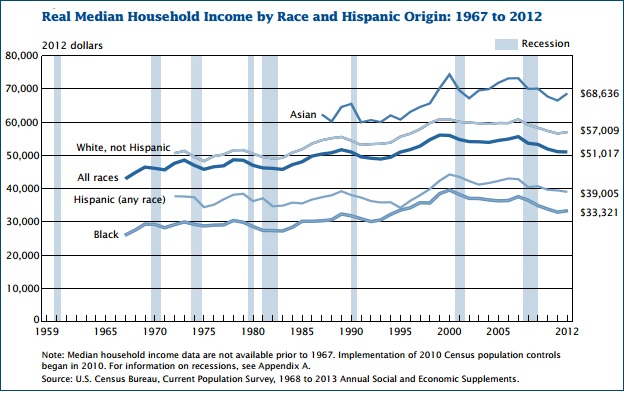
|
|

|
|
| April 24, 2024 |
|
Median income and poverty rate hold steady, Census Bureau finds 
WASHINGTON--Last year, for the first time in half a decade, median household income did not fall and poverty did not rise, the Census Bureau said Tuesday in the release of its major annual reporton poverty, insurance and earnings.
The report depicts an economy that has failed to improve the lot of most households and left about 46.5 million Americans living in poverty in 2012. “The poverty and income numbers are a metaphor for the entire economy,” said Ron Haskins of the Brookings Institution. “Everything’s on hold, but at a bad level.” He added, “Don’t expect things to change until the American economy begins to generate more jobs.” Median household income, adjusted for inflation, halted its fall at $51,017, about where it was the previous year. That is down about 9 percent from an inflation-adjusted peak of $56,080 in 1999, though the economy has grown by about 28 percent since then. Income is also down about 8.3 percent since 2007, when the economy started to contract. As the economy has expanded since the recession ended in 2009, income gains have accrued almost entirely to the top earners, the Census Bureau found. The census data shows that the top 5 percent of earners — households making more than about $191,000 a year — have recovered most of their losses and took in about as much in 2012 as they did before the recession hit. But those in the bottom 80 percent of the income distribution are, on average, making considerably less. In one glimmer of improvement, the number of men working full time year-round with earnings increased by one million between 2011 and 2012, to a total of 59 million. Still, the labor market continues to look weak for less-educated and lower-income men, as thelabor force participation rate of men has fallen steadily for the past 60 years. The West was the only region that experienced a statistically significant increase in median income, the Census Bureau said, while all other regions were flat. That most likely reflects the relatively strong growth in Washington, Oregon, California and Utah last year. North Dakota, experiencing an oil and gas boom, is the fastest-growing state, though its population is so small that it barely affects the national statistics. The poverty rate held steady at about 15 percent, about 2.5 percentage points higher than before the unusually long and deep economic downturn began. Neither the number nor the proportion of people living in poverty changed between 2011 and 2012, the Census Bureau found. No racial or ethnic group experienced significant changes. “The continued high rate of poverty is no surprise, given ongoing high unemployment, stagnant wages and government spending cuts,” Sheldon Danziger, the president of the Russell Sage Foundation, a nonprofit organization that studies poverty, said in a statement. “Unless we find ways to strengthen job opportunities and enhance the social safety net, we’ll continue to get disappointing news about the poverty rate from the Census Bureau each September.” The proportion of Americans without health insurance dropped to 15.4 percent in 2012 from 15.7 percent in 2011. Much of the change over the past two years has come from early provisions of the Affordable Care Act that are expanding coverage, especially a policy letting children up to age 26 remain on their parents’ health care plans. The health insurance figures in the report will help to form a baseline for a much sharper transformation coming next year, when at least 20 states will expand their Medicaid programs to cover millions of low-income Americans, with the federal government picking up most of the tab. The report underscores how disappointing the economic recovery has been for most families, even as businesses have generated record profits and the wealthy have been the chief beneficiaries of a rising stock market. “We are not where we want to be yet,” Treasury Secretary Jacob J. Lew said at the Economic Club of Washington before the report came out. “Too many Americans cannot find work, growth is not fast enough, and the very definition of what it means to be middle class is being undercut by trends in our economy that must be addressed.” But reversing the tidal economic trends that have battered the poor and the middle class would take significant policy changes that are unlikely to occur because of the sharp partisan divide in Washington. “The good news from today’s 2012 income and poverty results is that for the first year since the Great Recession hit, things aren’t getting worse,” Jared Bernstein of the Center on Budget and Policy Priorities, a former Obama economics official and a contributor to The New York Times’s Economix blog, wrote in his analysis of the numbers. “The bad news is that three years into an economic recovery, they’re not getting better either.” (Source: The New York Times) Story Date: September 18, 2013
|